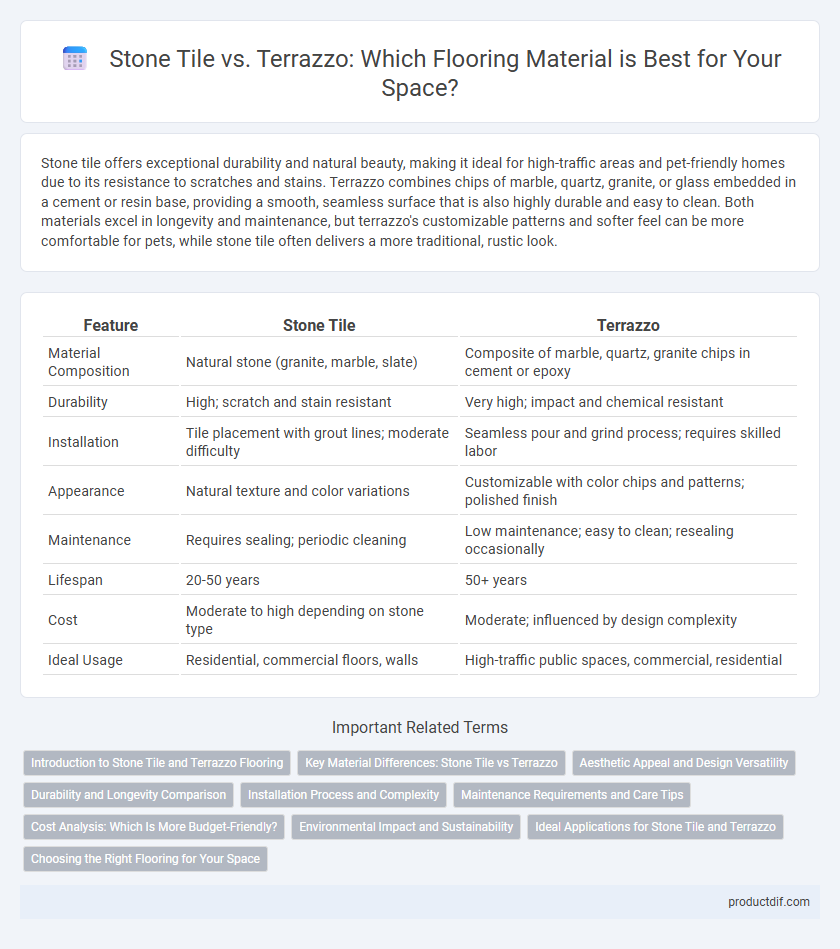Stone tile offers exceptional durability and natural beauty, making it ideal for high-traffic areas and pet-friendly homes due to its resistance to scratches and stains. Terrazzo combines chips of marble, quartz, granite, or glass embedded in a cement or resin base, providing a smooth, seamless surface that is also highly durable and easy to clean. Both materials excel in longevity and maintenance, but terrazzo's customizable patterns and softer feel can be more comfortable for pets, while stone tile often delivers a more traditional, rustic look.
Table of Comparison
| Feature | Stone Tile | Terrazzo |
|---|---|---|
| Material Composition | Natural stone (granite, marble, slate) | Composite of marble, quartz, granite chips in cement or epoxy |
| Durability | High; scratch and stain resistant | Very high; impact and chemical resistant |
| Installation | Tile placement with grout lines; moderate difficulty | Seamless pour and grind process; requires skilled labor |
| Appearance | Natural texture and color variations | Customizable with color chips and patterns; polished finish |
| Maintenance | Requires sealing; periodic cleaning | Low maintenance; easy to clean; resealing occasionally |
| Lifespan | 20-50 years | 50+ years |
| Cost | Moderate to high depending on stone type | Moderate; influenced by design complexity |
| Ideal Usage | Residential, commercial floors, walls | High-traffic public spaces, commercial, residential |
Introduction to Stone Tile and Terrazzo Flooring
Stone tile flooring, crafted from natural materials like granite, marble, or slate, offers exceptional durability and timeless aesthetic appeal. Terrazzo flooring combines marble, quartz, granite chips with a cement or epoxy binder, creating a highly customizable and resilient surface ideal for high-traffic areas. Both flooring options provide distinct design versatility and long-lasting performance, catering to various commercial and residential applications.
Key Material Differences: Stone Tile vs Terrazzo
Stone tile is composed of natural stone such as marble, granite, or slate, offering unique veining and color variations due to its organic origins. Terrazzo consists of a composite material made from chips of marble, quartz, granite, or glass embedded in a cement or epoxy resin binder, providing a customizable and consistent surface. The primary material difference lies in stone tile's natural, singular stone slabs versus terrazzo's engineered mixture that allows for diverse design patterns and enhanced durability.
Aesthetic Appeal and Design Versatility
Stone tiles offer a natural, timeless aesthetic with unique variations in color and texture that enhance any space. Terrazzo provides exceptional design versatility through its customizable composite of marble, quartz, or glass chips, allowing for intricate patterns and vibrant color combinations. Both materials elevate interiors, but terrazzo's adaptability makes it ideal for bold, modern designs while stone tiles suit classic, rustic, or elegant styles.
Durability and Longevity Comparison
Stone tile offers exceptional durability with natural resistance to wear, scratches, and stains, making it ideal for high-traffic areas. Terrazzo flooring combines marble, quartz, or glass chips embedded in cement or epoxy, providing a resilient surface that resists cracking and maintains its appearance over decades. Both materials excel in longevity, but terrazzo's seamless application often results in fewer maintenance needs, extending its lifespan beyond typical stone tile installations.
Installation Process and Complexity
Stone tile installation demands precise cutting and fitting, often requiring specialized tools and skilled labor to ensure durability and proper alignment. Terrazzo installation involves a more complex process including setting up a sturdy base, pouring and spreading the composite mixture, and multiple grinding and polishing stages to achieve a smooth, seamless finish. The intricate terrazzo method generally results in longer installation times and higher labor costs compared to the more straightforward stone tile placement.
Maintenance Requirements and Care Tips
Stone tile demands regular sealing and prompt cleaning to prevent stains and moisture damage, making its upkeep crucial for longevity. Terrazzo requires periodic polishing and resealing to maintain its glossy finish and resist wear from heavy foot traffic. Both materials benefit from using pH-neutral cleaners and avoiding abrasive tools to preserve surface integrity and appearance.
Cost Analysis: Which Is More Budget-Friendly?
Stone tile flooring typically costs between $5 to $15 per square foot, depending on the type of stone and installation complexity, while terrazzo ranges from $20 to $50 per square foot due to its labor-intensive process and custom design options. Initial investment for stone tile is generally lower, making it more budget-friendly for large areas or basic installations, whereas terrazzo's durability and low maintenance can translate to cost savings over time. Homeowners should weigh upfront expenses against long-term value when choosing between stone tile and terrazzo flooring.
Environmental Impact and Sustainability
Stone tile, sourced from natural quarries, offers durability but involves significant environmental costs due to mining and transportation emissions. Terrazzo flooring, composed of recycled glass, marble chips, and cement or resin binders, promotes sustainability by repurposing waste materials and reducing landfill contributions. The lower embodied energy and longer lifecycle of terrazzo make it a more eco-friendly flooring option compared to traditional stone tile.
Ideal Applications for Stone Tile and Terrazzo
Stone tile is ideal for outdoor patios, kitchen backsplashes, and high-traffic areas due to its durability, natural texture, and resistance to moisture. Terrazzo excels in commercial spaces, schools, and airports where expansive, seamless surfaces and low maintenance are essential. Both materials offer versatility, but stone tile suits rustic, heavy-use environments, while terrazzo fits contemporary designs requiring durability and aesthetic customization.
Choosing the Right Flooring for Your Space
Stone tile offers natural durability and unique patterns ideal for high-traffic areas, enhancing both aesthetics and functionality. Terrazzo flooring combines marble, quartz, and granite chips embedded in resin or cement, providing a customizable, polished surface with excellent resistance to wear and staining. Selecting the right flooring depends on factors like maintenance preferences, design style, and budget, with stone tile favored for traditional elegance and terrazzo for modern, versatile spaces.
Stone Tile vs Terrazzo Infographic

 productdif.com
productdif.com